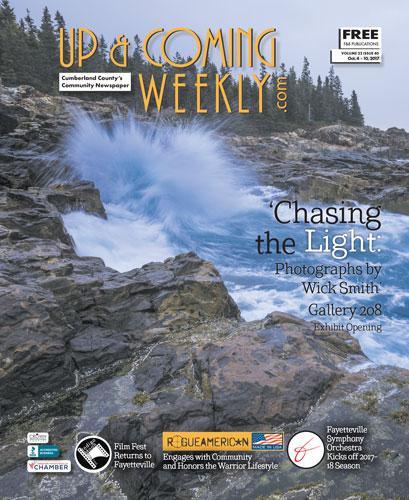 Wick Smith, like all artists, is confronted with questions: Why is he practicing this particular art form, why has he continued to practice being an artist over the years, and why did he choose this particular medium and subject matter? The answer to these questions can readily be summed up by those who visit Smith’s exhibit or attend the opening of “Chasing the Light” at Gallery 208 Oct. 10, when the word “beautiful” will be repeated over and over by visitors.
Wick Smith, like all artists, is confronted with questions: Why is he practicing this particular art form, why has he continued to practice being an artist over the years, and why did he choose this particular medium and subject matter? The answer to these questions can readily be summed up by those who visit Smith’s exhibit or attend the opening of “Chasing the Light” at Gallery 208 Oct. 10, when the word “beautiful” will be repeated over and over by visitors.
For this editorial, it was important to share some of the details of his lengthy journey to get to the “beautiful,” but more important to share insight about the work in ways that might influence visitors to see more than they would with a glance — to go beyond the idea of beauty. In attempting to articulate what I was seeing in this body of work, I interviewed Smith, researched his influences and even asked my photographer colleague, Shane Booth, to talk about what it means to be a landscape photographer.
My question to Booth was direct and overly simplified: “Why would a photographer want to take photographs of the landscape?” Booth’s acute response was a perfect description of the essence of Wick Smith’s landscapes: “They look at the landscape as an art form, and they can see it in a way that tells a story. Composition and capturing a moment is everything — you have to be at the right place at the right time. That moment tells a story of wherever they are.
Location is everything, and the artist shares a sense of place we would have missed if not captured.”
And that is how it began for Smith about 12 years ago. He simply wanted to take pictures of the landscape he enjoyed while he and his wife, Jane, were camping. “One day I had one of the digital photos blown up to a 16-by-20-inch print,” he said. “And it was stunning — the detail, composition and quality of the print. From that day, I began a serious approach to understanding photography; I continued to take photos, but I also began researching the manuals and attended workshops with nationally-known photographers.”
A photograph may capture the likeness of a place, but Smith’s images take us beyond the physicality of a place by evoking something intangible. We may call it beauty, but his intangible can reveal a deeper understanding of many things — timelessness, the spiritual or perfection, something that soothes us and heals us, or maybe it’s just something ineffable.
Smith gives credit to Richard Bernabe, who hosted Smith’s first workshop with an internationally known landscape photographer, for showing him where to “start looking to see composition in the field. I really didn’t have an idea of what I was looking at, and he patiently taught me how to understand composition,” Smith said. “As a result, I was able, over time, to develop the sensibility to see — all the photographers in the various workshops have taught me how to see — in a different way.”
For me, seeing Smith’s works over the years, I assumed he was a paid professional photographer, only to find out he is a businessman and the president of Biz Tools, a firm that develops websites for businesses. An avid and dedicated photographer, we cannot look at his work without sensing the art of photography is his personal passion. That dedication is how he lives up to Bernabe’s philosophy: “I can teach the mechanics of the camera, exposure and compositions … I can share my insights … but there are things I cannot teach. Curiosity is one of those things … Those who ultimately will be successful and keep moving on their own have passion and curiosity.”
Light is 75 percent of what Smith is interested in capturing, but he shared his process: “I have to be on-site before dawn and as the sun sets, using a tripod for long exposures to steady the camera.The post process of developing the print in the same light I witnessed it is very important. Even though I have to know what to do when I arrive, I have to take many, many pictures to get it right.”
It seems simple, but as Bill Fortney, one of his instructors, told Smith, “I have been at a site 25 times before the light was right.”
Photographs titled “Magical Reeds,” “Badlands at Dawn” and “The Old and the New” are examples of Smith moving away from the landscape as a vista to the landscape as an abstraction. Linear and atmospheric perspective are sacrificed for a flattened space, an open composition of surface, pattern, rhythm and color.
In these photographs Smith has shown us a new way of looking at something we may take for granted. The ordinary becomes extraordinary.
In “Chasing the Light,” visitors to Gallery 208 will also see some of Smith’s cityscapes. Influenced by photographer Ian Plant, in his cityscapes Smith focuses on shapes and lines to lead us through the composition. Familiar places around Fayetteville being viewed as shape, color and line are a pleasing contrast to the textured surfaces of the American landscape.
“Chasing the Light” opens at Up & Coming Weekly’s Gallery 208 at 208 Rowan St. on Oct. 10 from 5:30-7 p.m. A short gallery talk by the artist will begin at 6 p.m.
The public is invited to the opening, and for those who are not able to attend the opening, the gallery is open 9 a.m.-4 p.m. Monday through Friday until Dec. 10.
Call (910) 484-6200 for information, or visit www.upandcomingweekly.com.

 How to resolve AdBlock issue?
How to resolve AdBlock issue? 








